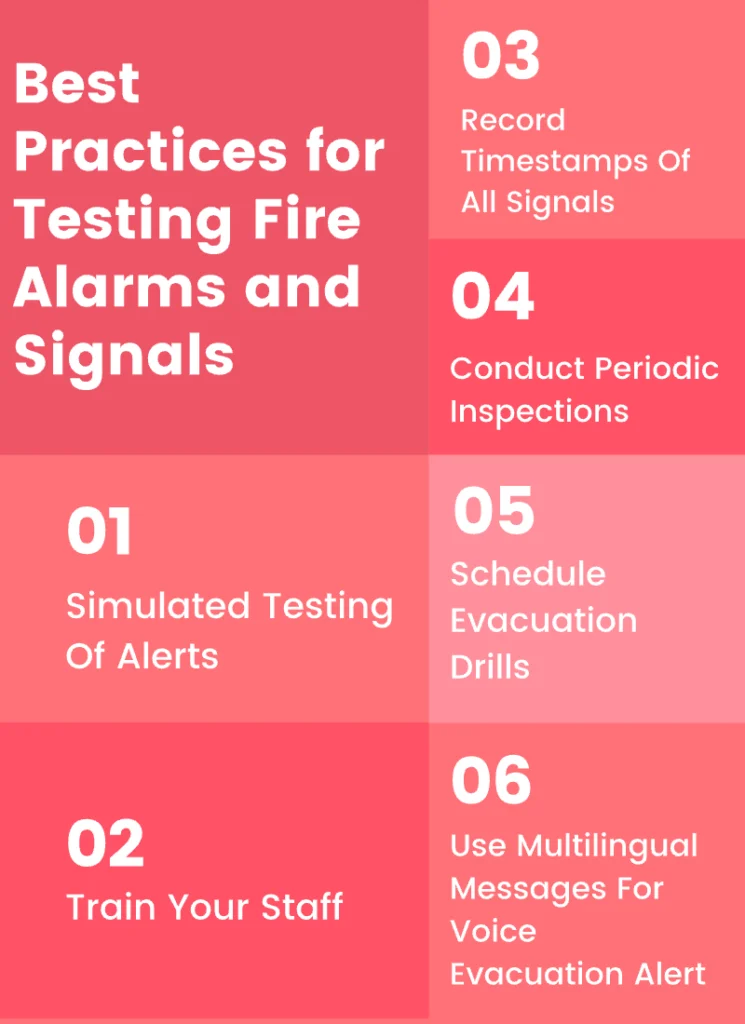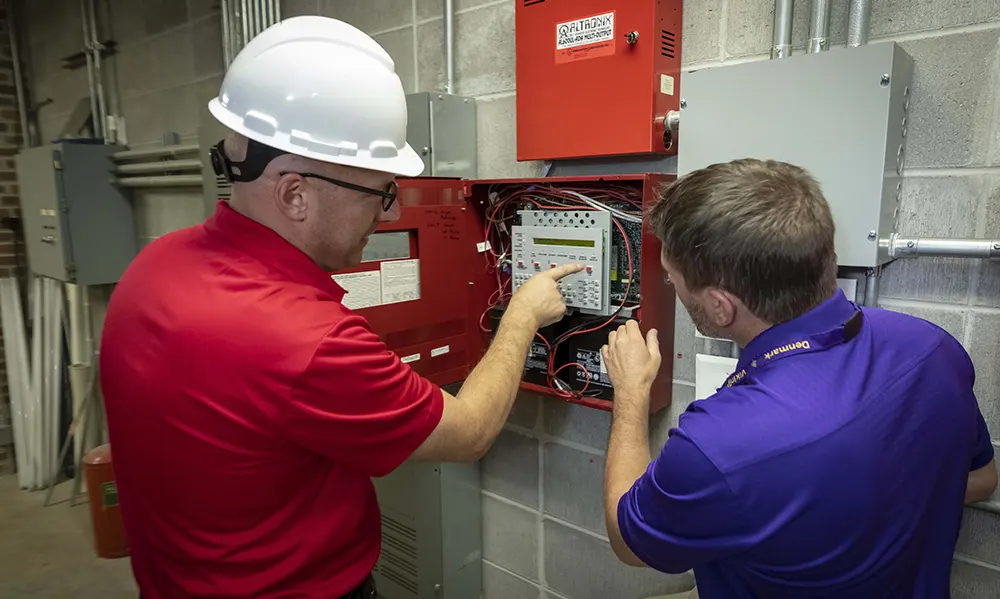Analyzing Alerts And Supervisory Signals of Fire Alarm Systems
Installing and testing your fire alarm system is the first step towards ensuring that your property and occupants are kept safe and protected from the terrors of accidental fires. But that’s not all. You need to check your fire alarm system regularly to ensure compatibility, integration with building automation systems, functionality during fail-safe operations, and tests during controlled and stimulated situations.
That is why advanced testing of your fire alarm systems is imperative. Keeping a laser focus on its reporting features, supervisory signals, and the functionality of voice evacuations to maximize the potential of these safety appliances makes a better fire protection system the best.
That is precisely what we aim to do in this blog. Here, we will cover vital aspects of advanced testing fire alarm systems on reporting, supervisory signals, and voice evacuation parameters.
Reporting Features Of Fire Alarm Systems
To assess the functionality of fire alarm systems, the primary step is to ensure that their reporting features are working according to the required standards of the building and its potential fire implications. It should be thoroughly reviewed to ensure that it is at its capacity and ability to act in sync with potential fire situations and provide a smoother protection strategy during egress.
Recommendations On Testing Reporting Features
Vital Documentation
All alert incidents should be documented for future reference and to improve your system’s efficiency in sending timely signals to individuals. Event logs should include the timestamp of the alert, the location of the alarm, acknowledgment of the alarm time, and the alarm UID. If there are situations of false alarms or inspection procedures that require instigating the alarms, the documentation should mention that as well.
Integration With Tools And System
Your fire alarm system should be integrated with the required systems and software to ensure proper reporting and alerting of individuals. The alerts from fire alarm systems should be connected to fire personnel and authority systems to notify them instantly in situations of a fire. Connecting to third-party tools and software also ensures better reporting and analysis of the situation and the alerts.
Steps And Best Practices
- Simulated Testings: conduct testing of your fire alarm system under various conditions to test its efficacy and functionality in controlled situations. Make the tests as elaborative as possible and keep all findings documented with precision. Review the reports periodically to ensure the system works at its fullest potential.
- Verify Report Accuracy And Recipient List: Ensure that alerts and notifications from the fire alarm system are accurate, timely, and at the right audible or visual level. The alerts correspond with the emergency at hand and are sent to the right personnel for extra monitoring and protection.
- Train Staff: Train your staff on basic steps and the actions that need to be taken once notifications and alerts are transmitted.
Here’s A Free Checklist For You To Test The Reporting Features Of Your Fire Alarm System

Fire Alarm System Supervisory Signals
In times of inoperability and dysfunctionality of your fire alarm systems, you need effective notification systems that alert you about the status of your devices. You wouldn’t want to depend on a dysfunctional device to save you from the perils of fire. Hence, supervisory signals are extremely necessary to keep your system under check and ensure they are in constant working condition.
Types And Response Approach For Supervisory Signals
Types Of Signals
There are three kinds of signal alerts: system alerts, tamper alerts, and maintenance alerts. System alerts occur when your system is affected by a communication disturbance, power failure, or low battery. Tamper alerts occur when someone tampers with the devices, and maintenance alerts occur when your system indicates that your devices need to be changed or replaced or any kind of system malfunction has prevailed.
Response Procedures
Once your alarm devices send across supervisory signals, the primary step is to adjust and make the necessary changes to enable proper functioning back again. Any and all supervisory signals should be accurately documented and reviewed from time to time to ensure that all systems are healthy and do not require emergency adjustments.
Steps And Best Practices
- Stimulated Testing: Schedule periodic testing of your fire alarm system’s supervisory signals by setting up situations where the signals are triggered. Make sure all types of alerts are tested to guarantee the signals’ proper functioning and their ability to notify in such situations effectively.
- Appropriate Logging And Action-Triggering: Make sure to log accurately the timestamps of your supervisory signals for the record. Every time the alerts are triggered due to tampering or maintenance issues, the perfect record should be in place to analyze and predict the devices’ workings. This can help you explore the workings of your devices and mitigate unforeseen future risks.
- Regular Inspection and Testing: Schedule regular inspections and testing of your devices to test their supervisory signals and ensure they notify you at the most appropriate time. If not, adjustments and repair work are the first priority to ensure your fire alarm devices are in working order.
Here’s A Free Checklist For You To Test The Supervisory Signals Of Your Fire Alarm System

Fire Alarm System Voice Evacuation Messages
Besides signals and emergency alerts, voice evacuation messages make the evacuation procedure more precise and instructive. Evacuation alerts that use voice-stimulated instructions provide relief to occupants in the sense that they provide them with guided instruction on how to egress and evacuate safely, quickly, and in the best way possible.
Recommendations For Voice Evacuation Messages
Audibility And Intelligibility
Your messages should be audible and straightforward to understand. To achieve this, you need to assess the sound level of your voice message. Make sure that it reaches the entirety of your property and is audible to individuals, irrespective of their position anywhere within the property. Use clear recording files to ensure the voice message doesn’t break off or sound scratchy.
Different Messages For Different Scenarios
Different emergency requires different messages. Hence, multiple recordings should always be kept to satisfy the requirements for each session. You want to be precise with your messages to enable clear instructions for a smoother egress procedure.
Steps And Best Practices
- Evacuation Drills: Schedule evacuation drills periodically to familiarize your occupants and staff with the voice evacuation messages. This can help them not panic in actual emergency situations and practice the procedure beforehand for efficiency.
- Feedback Loops: Have your occupants and staff provide feedback on the voice evacuation messages. Gather insights on improving them and making them more appropriate for the emergency. You can get better ideas on the exact keywords and how to shorten them while being comprehensive to ensure a quicker egress.
- Usage of Multilingual Messages: In addition to using just the universal language to develop your voice evacuation messages, you can add the same messages in different languages for ease of understanding among occupants from various backgrounds. You can use the regional language and any other language most occupants hail from. Not just comprehensiveness but this will also make occupants feel more comfortable and included.
Here’s A Free Checklist For You To Test The Voice Evacuation Messages Of Your Fire Alarm System
Conclusion
Having your fire alarms tested in a refined way is beneficial not only for a better protection system for your property and occupants but also for gaining everyone’s confidence in considering your property an anti-danger zone from fire, and maintaining reviewing logs is also necessary.. Hence, it’s imperative that special focus is given to the fire alarm’s reporting features, supervisory signals, and the functionality of voice evacuations to create a safer and more protected environment for all individuals around.
Explore more templates
Enhance Communication: Download Our Fire Alarm System Voice Evacuation Message Testing Template. Simplify assessments with this comprehensive guide.
Streamline your fire safety protocol with our comprehensive Testing of Fire Alarm System Supervisory Signals checklist.
Introducing our Testing of Fire Alarm System Reporting Features template – your comprehensive solution for documenting and analyzing fire alarm system tests.
Tailored to meet your specific requirements, enabling you to manage
inspections and reports with greater detail and efficiency
ZenFire is a lot more customized to my business. Before I was using a generic app, I could not customize, like I do now."
